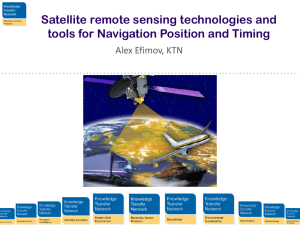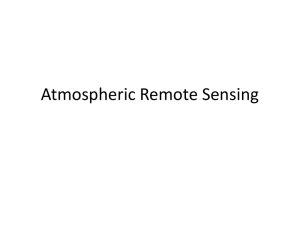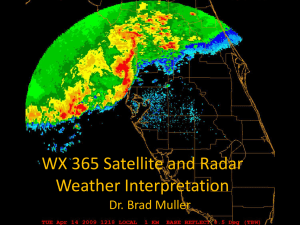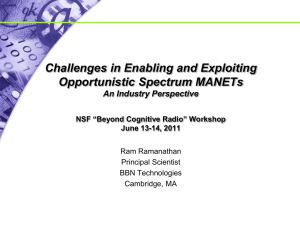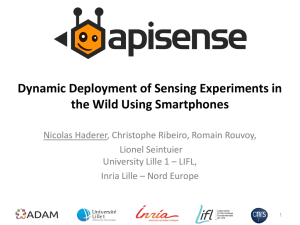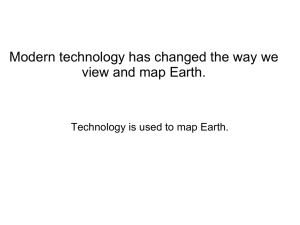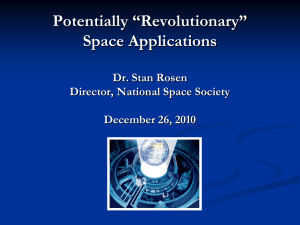ShahMurad Presentation
advertisement
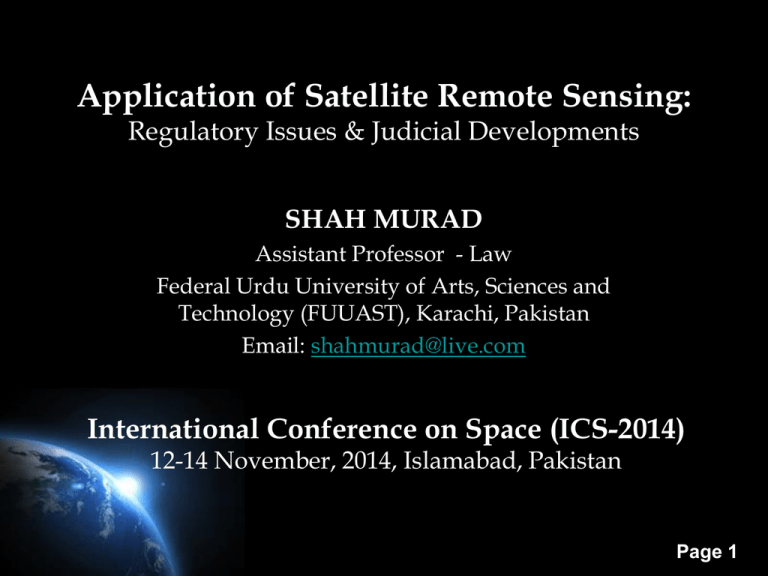
Application of Satellite Remote Sensing: Regulatory Issues & Judicial Developments SHAH MURAD Assistant Professor - Law Federal Urdu University of Arts, Sciences and Technology (FUUAST), Karachi, Pakistan Email: shahmurad@live.com International Conference on Space (ICS-2014) 12-14 November, 2014, Islamabad, Pakistan Page 1 Outline • Abstract • Introduction • Satellite Remote Sensing in Pakistan • Regulation of Satellite Remote Sensing • Legal Issues in Satellite Remote Sensing • Supreme Court of Pakistan on Satellite Remote Sensing • Conclusion Page 2 We are imaging the planet to save the planet. Will Marshall, CEO & Co-founder of Planet Lab Page 3 Abstract Technological advancements in application of satellite remote sensing have provided tremendous benefits to the modern society ranging from weather forecasting to disaster management. But these technological innovations have also been a major catalyst for legal implications and subsequently paved the way for legislation. Similarly, the United Nations Committee on the Peaceful Uses of Outer Space (UNCOPUOS) has developed an international set of norms, Principles Relating to Remote Sensing of the Earth from Outer Space, which provide a primary guideline for policy making on the satellite remote sensing. By contrast with advanced space-faring nations, Pakistan is also using remote sensing technology in various disciplines for socio-economic development of the country. However, there is no law and policy in Pakistan to regulate the collection, access, distribution, sharing, archiving, and legal validity of remote sensing data. In view of the legal issues faced by the public and private sector, it is imperative to develop an adequate legal framework at the national level to deal with legal implications involved in application of satellite remote sensing. Page 4 Introduction • Definition: – Remote sensing is a method in which electromagnetic radiation (EMR) is used for collection and analysis of information of about the earth (or other physical objects) without making physical contact. • Term: – A geographer, Ms. Evelyn Pruitt, working with the Office of Naval Research, the United States, coined the term ‘remote sensing’ in the mid 1950s. Page 5 Introduction (cont…) • The origins of remote sensing can be tracked to the fourth century BC when Aristotle in the quest of explaining the motion of the planets, used a camera obscura (an instrument explained by Aristotle in his Problems but perhaps known even earlier). • In 1850s the aerial photography was introduced and to some extent cameras were carried into the air by pigeons, kites and balloons. • In 1903, the piloted airplanes paved the way for remote sensing through camera which later served as sophisticated tool for intelligence gathering through aerial surveillance. In the same period, the military value of remote sensing through aerial photography was significantly proven, particularly in the World I and the World War II. Page 6 Introduction (cont…) • The first ever remote sensing instrument was used in the Vanguard 2 which was launched in February, 1959, specifically designed to observe the cloud distribution of the Earth but unfortunately its images were uninterruptable. • Later on, in April, 1960, TIROS 1 (Television and Infra-Red Observation Satellite), first ever meteorological satellite, was successfully launched as a part of the meteorological mission. • However, with launch of LANDSAT 1 satellite in 1972, the era of remote sensing systems was officially opened to the scientific community and subsequently by LANDSAT 2, in 1975, and LANDSAT3, in l978. Page 7 Introduction (cont…) • On October 4, 1957, the ‘space age’ officially came into existence when the former Soviet Union successfully launched the first artificial earth satellite, Sputnik 1, in low earth orbit. • But in the early 1960s, a major breakthrough was seen when man-made satellites triggered the remote sensing. • Prior to 1960s the remote sensing was largely based on airborne. Page 8 Satellite Remote Sensing in Pakistan • Like other space-faring nations, Pakistan is also using remote sensing technology in a wide spectrum of activities, particularly for catering socio-economic needs of the country. At present, Pakistan has no remote sensing satellite or earth observation satellite. • The SUPARCO, the Pakistan national space agency, is receiving, processing, storing, sharing and providing satellite remote sensing data to the government organizations and private sector. However, at present there is remote sensing agency in Pakistan empowered under law for providing remote sensing data to local buyers like in case of India. Page 9 Regulation of Satellite Remote Sensing • Civilian remote sensing programmes are administrated by the national and international governmental institutions such as NASA in the USA, ESA in Europe, Interkosmos in Russia, CNES in France, NASDA in Japan, ISRO in India, and Suparco in Pakistan, etc. • However, in recent years, a tendency towards commercialization of remote sensing from space becomes apparent in the Western world. Page 10 Legal Issues in Satellite Remote Sensing Page 11 Regulation of SRS (Cont…) The UN General Assembly adopted the UN Principles Relating to Remote Sensing of the Earth from Outer Space, on 3rd December 1986 (UNGA Resolution 41/65). Pakistan adhered to these Principles in its conduct of satellite remote sensing activities. The remote sensing principles address the sensing of Earth from space for purpose of improving natural resource management, land use and the protection of the environment. Page 12 Legal Status of UN Principles on Remote Sensing • The Principles on Remote Sensing serve as general guidelines for conducting remote sensing from outer space but they are not binding. • However, no dispute or conflict has arisen concerning this area and no case law clarifies the legal application of the guidelines. Page 13 Use of Remote Sensing Data in the Courts Evidence from satellite remote sensing has been accepted as evidence in cases before the International Court of Justice (ICJ) and in growing number of national courts across the world. For example, in India, the Supreme of India and the High Courts have used satellite images as admissible evidence in forest encroachment cases to ensure compliance with Forest Conversation Act, 1980. In fact, the Supreme Court of India has established the Central Empowered Committee, which is a subsidiary body to review such evidence. Page 14 SRS and Intellectual Property Commercialization of remote sensing services, data processing and distribution in the future, will undoubtedly raise IPR protection issues among other legal matters. It is important questions pertains to whether SUPARCO could or should retain jurisdiction over remote sensing data enhanced in distribution centers and then sold as derived product, i.e. a map. Because copyright does not protects data but protects only its form of expression, it becomes imperative to define what constitutes protectable expression of remote sensing data. Page 15 SRS and Privacy Depending on the detail of the images, it may be that the privacy rights of an individual are breached by satellite earth observation activities. In general, there is a breach when the data is such as to identify that individual and disclose personal information relating to the individual. Public authorities have a positive obligation to make available environmental information held by them. Page 16 Access to SRS Data • There is no ‘supervision’ and ‘control’ possible after the data have been sold. But States wanted guaranteed access to remote sensing information and this as soon as possible data concerning its territory, as produced, on a non-discriminatory basis and on reasonable cost terms. • The question of accessing remote sensing data depends on a number of elements, for example on the status of the entity that wants to access and in which stage of the remote sensing data acquisition it plans to access. Page 17 SRS Image as Evidence Satellite images have been used for verification purposes and to support the settlement of environment-related disputes. Satellite images have been presented in the international court as well as in the national courts across the world. Starting with international case, satellite images were introduced in Mali v. Burkina Faso [1986 ICJ 554, ICJ Reports] where the Court considered that maps could not constitute a binding document or a territorial title by themselves, unless the parties concerned had expressed their acceptance. Page 18 SRS Image as Evidence (cont…) Satellite images were also introduced in a case concerning maritime delimitation and a question of territorial boundaries, Qatar v. Bahrain [2001 ICJ Report] in March, 2001. The dispute concerned the existence of a natural channel that was later blocked by the construction of refinery. SPOT data were used at the hearing for Bahrain, and Landsat data were used to image the shallow water areas as a measure of accuracy of the bathymetric charts. Page 19 Supreme Court of Pakistan on Satellite Remote Sensing The Supreme Court in the case Suo Motu Case No. 16 of 2011 [PLD 2013 Supreme Court 443] regarding implementation proceedings of Judgment of Supreme Court in the case of Watan Party and another v. Federation of Pakistan and others (PLD 2011 Supreme Court 997) directed the Provincial Board of Revenue to collect information on the basis of satellite imagery for whole of the Karachi to identify the encroachments by the landgrabbers. Page 20 Conclusion • Use of space-based technology in Pakistan is expanding. SUPARCO is endeavoring to facilitate its users by significantly contributing to enhance the pace of socio-economic development in several sectors through application of space technology. • The satellite remote sensing market is vibrant while value of high-resolution images of the Earth from space is increasing day by day in the public and commercial sector. A growing number of countries have adopted national laws and internal regulations governing satellite remote sensing. • National space laws and policies are meant to implement international space law norms and to make sure that space activities do not undermine international obligations and security interests. Page 21

